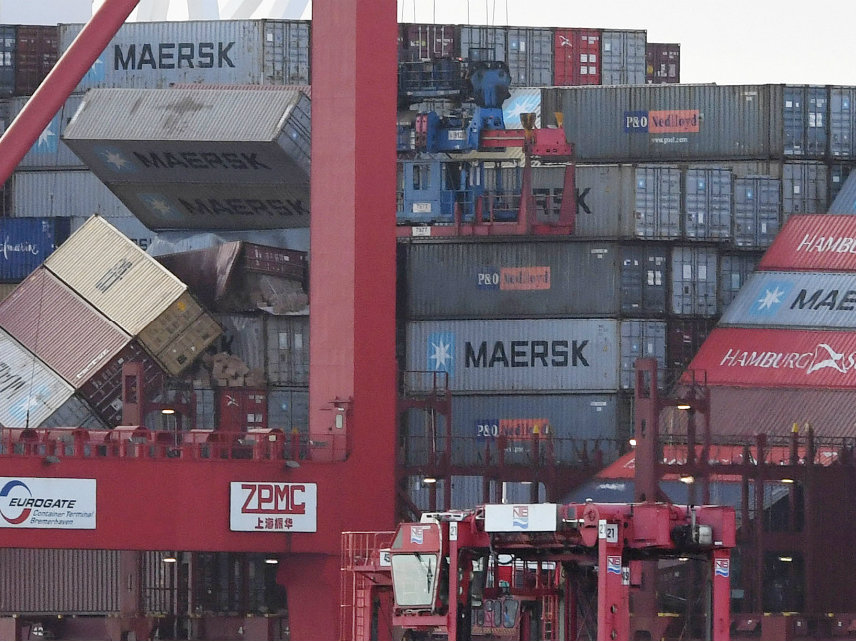Trump's Tariffs Cost the U.S. Economy $1.4 Billion Every Month
New study shows U.S. consumers pay every dollar of the tariffs, which have also damaged supply chains and the availability of goods.

Tariffs imposed by President Donald Trump during 2018 cost the U.S. economy $6.9 billion last year—above and beyond the $12.3 billion paid by American consumers and importers to the federal government.
That's the conclusion of a new economic analysis of the Trump trade war published this week by Centre for Economic Policy Research, a London-based think tank, by a trio of economists from the Federal Reserve Bank of New York, Princeton University, and Columbia University. The paper draws an important but sometimes ignored distinction between the cost of the tariffs as a form of taxation and the broader economic effects of raising barriers to trade. Americans are paying both those "seen" costs in the form of higher taxes, as well as the "unseen" spillover costs—known as "deadweight loss" in economist lingo—created by the tariffs.
By the end of last year, after ramping up tariffs over the course of several months, the deadweight loss of Trump's tariffs totaled $1.4 billion each month, according to Mary Amiti, Stephen J. Redding, and David Weinstein, the three researchers.
"We find that the U.S. tariffs were almost completely passed through into U.S. domestic prices, so that the entire incidence of the tariffs fell on domestic consumers and importers," they concluded.
Evidence of broader, negative economic consequences of the tariffs blows a major hole in the Trump administration's big three economic arguments for its protectionist trade policies.
First, Trump has argued that the tariffs benefit the U.S. government because they are generating revenue that could be used to close the budget deficit. This is technically correct because tariff revenue does flow into the U.S. Treasury, but the billions generated by the trade war has not slowed the growth of the federal budget defict. In any case, if the tariffs are draining $1.4 billion out of the economy every month beyond the cost of the taxes paid by U.S. importers, it becomes even more of a stretch for Trump to claim that the tariffs are benefiting the country, its economy, or the federal government.
"Our results imply that the tariff revenue the U.S. is now collecting is insufficient to compensate the losses being born by the consumers of imports," the researchers conclude.
The second argument Trump has made for the tariffs is that they are needed to create leverage on other nations in order to negotiate better trade deals. Trump has explicitly credited the tariffs with helping negotiate the new United States-Mexico-Canada Agreement (USMCA), a more protectionist replacement for the North American Free Trade Agreement (NAFTA), and has made it obvious that he believes tariffs on Chinese goods will pave the way to a new trade deal with China.
But Amiti, Redding, and Weinstein found "little evidence of such an improvement in the terms of trade." One of the main points of contention in the Trump administration's efforts to reach a trade deal with China has been the supposed theft of U.S. intellectual property by Chinese firms, but even if a future trade deal resulted in the Chinese paying an additional 25 percent in royalties for U.S. intellectual property, it would take three years of payments to make up for the damage inflicted on U.S. companies by the first 11 months of Trump's trade war.
Finally, Trump has claimed that tariffs will help resurrect American manufacturing jobs and prevent further offshoring of blue collar work to cheaper labor markets in Mexico, China, and elsewhere.
But even if the trade war could bring back 35,400 manufacturing jobs—equal to the number of American steel- and aluminum-producing jobs lost in the past decade—the deadweight loss to the economy would be about $195,000 per job, "which is almost four times more than the annual wage of a steel worker," the trio concludes.
An economic white paper is unlikely to sway Trump's opinion about tariffs—he's the Tariff Man, after all—but this analysis is the most comprehensive summary yet of the ongoing costs of the White House's misguided protectionism. More than a year after Trump assured Americans that his trade war would be "good, and easy to win," the data strongly suggest otherwise.
Show Comments (53)